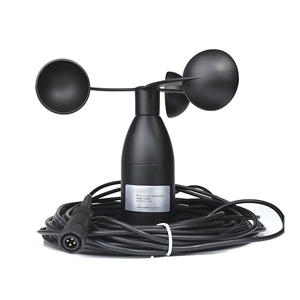What is a 3-Cup Anemometer?
An anemometer is an instrument that measures the speed of air. There are many types of it, and the three-cup anemometer is widely used. Robinson in the United Kingdom invented the rotating cup anemometer, and it was four cups at that time, and then it was changed to three cups. The three parabolic or hemispherical empty cups fixed to each other on the rack are all in one direction, and the entire rack together with the wind cup is mounted on a freely rotatable shaft. The three-cup anemometer commonly used in meteorological stations is composed of three parabolic cone empty cups fixed on the bracket at 120° to each other, and the concave surfaces of the empty cups are all in one direction. The entire induction part is installed on a vertical rotating shaft. Under the action of wind, the wind cup rotates around the shaft at speed proportional to the wind speed. Another type of rotary anemometer is the propeller anemometer, which consists of a three-blade or four-blade propeller to form a sensing part, which is installed at the front end of a wind vane so that it is always aligned with the direction of the wind. The blades rotate about the horizontal axis at a speed proportional to the wind speed.
3-cup anemometers can be flexibly used in all fields and are widely used in electric power, steel, petrochemical, energy-saving and other industries. Olympic sailing competitions, rowing competitions, field shooting competitions, etc. all need to use anemometers to measure. Today's anemometers are more advanced. In addition to measuring wind speed, they can also measure wind temperature and air volume. There are many industries that need to use anemometers. The recommended industries are the fishing industry, various fan manufacturing industries, industries that require exhaust systems, and so on.
Functions and Features
- ATO three-cup anemometer appearance structure design is reasonable, beautiful, small in size, easy to carry, and easy to install.
- High measurement accuracy, wide range and good stability.
- It has strong corrosion resistance and weather resistance.
- The three-cup anemometer has good dynamic characteristics, strong anti-interference ability and high measurement accuracy.
- Low power consumption, long circuit life and long-term stable operation.
- It has a wide power adaptability range, good data information linearity, and a long signal transmission distance.
How to detect a 3-cup anemometer?
- Air volume and wind speed detection must be carried out first. All purification effects are obtained under the designed air volume and speed.
- Before the test, it is necessary to check whether the fan is running normally, and the size of the tested air outlet and air duct must be measured on the spot.
- For a one-way flow cleanroom, the air volume is determined by the method of the average wind speed of the room section and the product of the clean area.
Take the section that is 0.3m away from the filter and perpendicular to the airflow as the sampling section. The distance between the test points should not be greater than 0.6m. Set no less than 5 test points on the section. The arithmetic mean of all readings is taken as the average wind speed. The measurement section of the vertical one-way flow cleanroom is based on the horizontal section of 0.8m to 1m on the ground. The measurement section of the horizontal one-way flow cleanroom is taken from the vertical section of 0.5m to 1m on the air supply surface. The number of test points on the section should not be less than 10, and the spacing should not be greater than 2m, and they should be evenly arranged. - For the tuyere with a filter, the air volume is determined by the product of the average wind speed of the tuyere section and the net sectional area of the tuyere. (The average wind speed is obtained from no less than 6 evenly arranged test points on the section of the tuyere or the section where the auxiliary air duct is cited.)
- When there is a long branch pipe section on the windward side of the tuyere and holes have been or can be drilled, the air volume can be determined by the air duct method.
- For the rectangular air duct, divide the measuring section into several equal small sections, each small section is as square as possible, the side length is not more than 200mm, the test point is located in the center of the small section, but the whole section should not be less than 3 tests For a circular air duct, the measurement section should be divided according to the equal-area ring method and the number of test points should be determined; a hole should be made on the outer wall of the air duct, and a thermal anemometer probe or pitot tube should be inserted. The measured dynamic pressure is converted into air volume.

